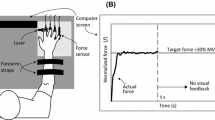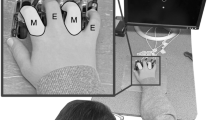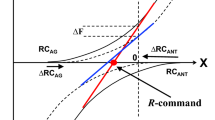Abstract
Previous reports show that the forces produced by the fingers of one hand drop exponentially over time in the absence of visual feedback on the forces. We study the force production by the index fingers of both hands with no visual feedback. Subjects produced a specified total force with a specific contribution from each finger by pressing on force sensors. We observed that in the absence of visual feedback: (1) The finger forces dropped with time by an amount proportional to the magnitude of the initial force. For low initial force values (<7 % of MVC of individual finger force), the finger forces showed an increase; (2) the total force (sum of finger forces) evolution showed similar features; (3) finger forces changed in a way that facilitated more equitable force production by the two fingers; (4) all the force–time changes resemble exponential functions with similar time constants (~15 s). We propose that two processes interact to produce these patterns. (1) RC back-coupling: The central nervous system defines referent coordinates (RCs) for the digit tips, and the difference between the referent and actual coordinates leads to force production. If actual coordinates are not allowed to move to referent ones, referent coordinates show a slow drift toward the actual ones, leading to a force drop. (2) Sensory adaptation: This process, possibly related to sensory receptor characteristics, leads to an increase in finger force. RC back-coupling provides a common account of this and other reported phenomena of hand force or position changes across transient, external perturbations.





Similar content being viewed by others
References
Ambike S, Paclet F, Zatsiorsky VM, Latash ML (2014) Factors affecting grip force: anatomy, mechanics, and referent configurations. Exp Brain Res 232:1219–1231. doi:10.1007/s00221-014-3838-8
Feldman AG (1986) Once more on the equilibrium-point hypothesis (λ-model) for motor control. J Mot Behav 18:17–54
Feldman AG (2009) Origin and advances of the equilibrium-point hypothesis. Adv Exp Med Biol 629:637–643
Feldman AG (2011) Space and time in the context of equilibrium-point theory. Wiley Cogn Sci 2:287–304
Feldman AG, Latash ML (2005) Testing hypotheses and the advancement of science: recent attempts to falsify the equilibrium point hypothesis. Exp Brain Res 161:91–103
Gardner EP, Martin JH, Jessell TM (2000) The Bodily Senses. In: Kandel ER, Schwartz JH, Jessell TM (eds) Principles of neural science, 4th edn. McGraw-Hill, New York
Iggo A, Muir AR (1969) The structure and function of a slowly adapting touch corpuscle in hairy skin. J Physiol 200:763–796
Latash ML (2010) Motor synergies and the equilibrium-point hypothesis. Mot Control 14:294–322
Latash ML, Shim JK, Smilga AV, Zatsiorsky VM (2005) A central back-coupling hypothesis on the organization of motor synergies: a physical metaphor and a neural model. Biol Cybern 92:186–191
Li Z-M, Latash ML, Zatsiorsky VM (1998) Force sharing among fingers as a model of the redundancy problem. Exp Brain Res 119:276–286
Li S, Danion F, Latash ML, Li Z-M, Zatsiorsky VM (2001) Bilateral deficit and symmetry in finger force production during two-hand multi-finger tasks. Exp Brain Res 141:530–540
Martin V, Scholz JP, Schoner G (2009) Redundancy, self-motion, and motor control. Neural Comput 21:1371–1414
Reinkensmeyer DJ, Akoner O, Ferris DP, Gordon KE (2009) Slacking by the human motor system: computational models and implications for robotic orthosis. IEEE Eng Med Biol Soc 2009:2129–2132. doi:10.1109/IEMBS.2009.5333978
Secoli R, Milot MH, Rosati G, Reinkensmeyer DJ (2011) Effect of visual distraction and auditory feedback on patient effort during robot-assisted movement training after stroke. J Neuroeng Rehabil 8:21. doi:10.1186/1743-0003-8-21
Shapkova EY, Shapkova AL, Goodman SR, Zatsiorsky VM, Latash ML (2008) Do synergies decrease force variability? A study of single-finger and multi-finger force production. Exp Brain Res 188:411–425
Singh T, Zatsiorsky VM, Latash ML (2012) Effects of fatigue on synergies in a hierarchical system. Hum Mov Sci 31:1379–1398. doi:10.1016/j.humov.2012.06.008
Slifkin AB, Vaillancourt DE, Newell KM (2000) Intermittency in the control of continuous force production. J Neurophysiol 84:1708–1718
Sun Y, Zatsiorsky VM, Latash ML (2011a) Prehension of half-full and half-empty glasses: time and history effects on multi-digit coordination. Exp Brain Res 209:571–585
Sun Y, Park J, Zatsiorsky VM, Latash ML (2011b) Prehension synergies during smooth changes of the external torque. Exp Brain Res 213:493–506
Vaillancourt DE, Russell DM (2002) Temporal capacity of short-term visuomotor memory in continuous force production. Exp Brain Res 145:275–285
Vaillancourt DE, Slifkin AB, Newell KM (2001) Visual control of isometric force in Parkinson’s disease. Neurophysiologia 39:1410–1418
Wilhelm L, Zatsiorsky VM, Latash ML (2013) Equifinality and its violations in a redundant system: multi-finger accurate force production. J Neurophysiol 110:1965–1973
Wolbrecht ET, Chan V, Reinkensmeyer DJ, Bobrow JE (2008) Optimizing compliant, model-based robotic assistance to promote neurohabilitation. IEEE Trans Neural Syst Rehabil Eng 16:286–297. doi:10.1109/TNSRE.2008.918389
Zatsiorsky VM, Li Z-M, Latash ML (1998) Coordinated force production in multi-finger tasks. Finger interaction and neural network modeling. Biol Cybern 79:139–150
Zatsiorsky VM, Li Z-M, Latash ML (2000) Enslaving effects in multi-finger force production. Exp Brain Res 131:187–195
Zhou T, Solnik S, Wu Y-H, Latash ML (2014) Unintentional movements produced by back-coupling between the actual and referent body configurations: Violations of equifinality in multi-joint positional tasks. Exp Brain Res. doi:10.1007/s00221-014-4059-x
Acknowledgments
The study was in part supported by NIH Grants NS-035032 and AR-048563.
Author information
Authors and Affiliations
Corresponding author
Rights and permissions
About this article
Cite this article
Ambike, S., Zatsiorsky, V.M. & Latash, M.L. Processes underlying unintentional finger-force changes in the absence of visual feedback. Exp Brain Res 233, 711–721 (2015). https://doi.org/10.1007/s00221-014-4148-x
Received:
Accepted:
Published:
Issue Date:
DOI: https://doi.org/10.1007/s00221-014-4148-x




